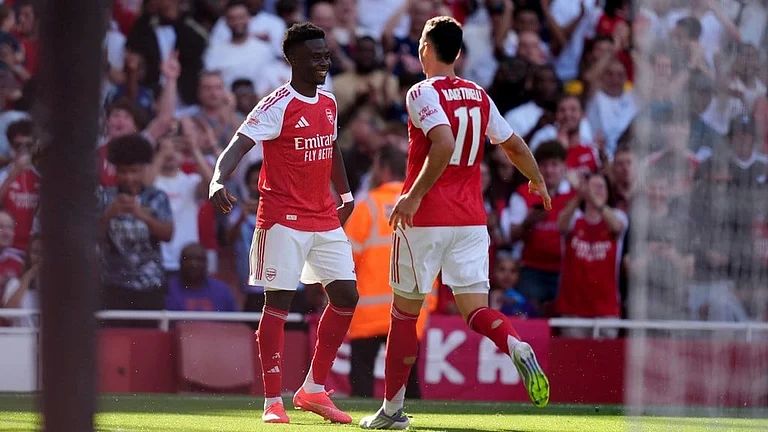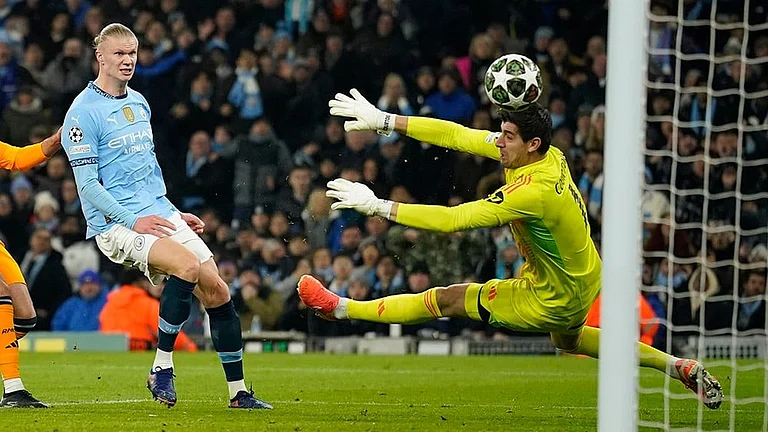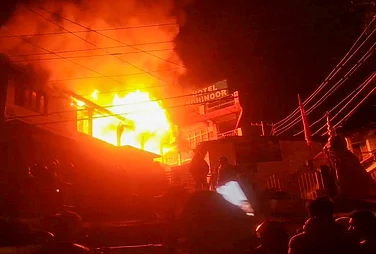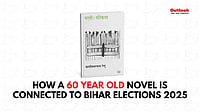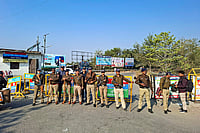“Water remembers everything it travels over and through.
If you have been in water, part of you remains there still.”
—Natalie Diaz, ‘Postcolonial Love Poem’, 2020
Every year around the time of Chhath Puja in India, the issue of toxic frothing in certain stretches of the Yamuna River in Delhi hogs the headlines. Pollution in the Yamuna has become a part of our quotidian existence, so much so that it makes for compelling photos but fails to shock anyone anymore.
In the summer of 2021, however, objects way more disturbing than froth floated in the river and left many shocked —corpses. Hamirpur residents in Uttar Pradesh spotted the bodies and reported them to the police amid the deadly second wave of the pandemic. A local councillor at the time claimed that bodies were being dumped into the river to avoid infections because crematoriums were overflowing with Covid-19 victims.
Three years since the Covid-19 outbreak and nearly two years since the appearance of the floating bodies, the Yamuna remains a contentious site.
In the ongoing photo exhibition titled ‘Chasing a Dying River: Ghat 24 Yamuna, Delhi, India’, which runs till the end of August in New York, artists and academics Praveen K Chaudhry and Souzeina Mushtaq look at the river as a site of political posturing at the intersection of ritualistic faith and industrial greed.
These images, which document the historic ‘Ghat 24’, one of the 32 contiguous stairways that dot the Yamuna’s shores, are testimony to the human contradictions that characterise daily life on the ghats. It is a site where “deep spirituality and environmental indifference intertwine and coexist”, says Chaudhry, who teaches political science at the State University of New York. “It is actually looking at the images of dead bodies on this river in India that made us realise how important this work is and how badly this river is treated. It is a shame but true,” he adds.
The artists’ work is informed by their keen observation of the politics of pollution and beautification centered around the river. The photo exhibition features a crematorium, a subway system, a modern highway, and the new crowd of ‘hustling’ TikTokers pretending the froth is snow.
The photos bear witness to the trying times the country faced during the pandemic which caused uncountable deaths, symbolised perhaps by the dying Yamuna: they raise questions about the dichotomy reflected in India’s relationship with the river, which is both worshipped and systematically abused.
Quoting the 1999 Citizens’ Fifth Report, Chaudhry says, “Indians, including the river-worshipping Hindus, do not think twice before polluting a river.”
The overarching impact that the pandemic has had on people is also visible in another set of photos that Chaudhry and Mushtaq put together. Before focusing on the Yamuna as a site of contestation, the duo looked at their own city in the United States, which they now call home, through equally powerful visual storytelling.
“We worked on the New York City project and the Yamuna project during the Covid-19 pandemic as we could not travel to the communities that we usually work on — the nomads and weavers in the Himalayas, in Turkey, and other regions,” Chaudhry says.
The City That Never Sleeps
In March 2020, New York, the city that never sleeps, came to an abrupt halt. Empty subway trains rattled over its tracks. Shutters were pulled down on offices, shop fronts, schools, theatres, parks and gyms as the novel coronavirus (SARS-CoV-2) confined people to their homes.
Times Square resembled a graveyard where the ‘American Dream’ came to die, with gleaming signs standing as relics of the city’s former glory. The silence was pierced only by the blood-curdling shrieks of ambulance sirens.
That is the city that Chaudhry and Mushtaq remember when asked about those early days of the lockdown — the unprecedented catastrophe on a hitherto unimagined scale that changed the way life was forever.
But even a deadly virus could not deter the fight against injustice. The empty streets were once again filled with people as mass protests erupted in cities across the US, including New York, following the murder of George Floyd in May. “Black Lives Matter” slogans now intermingled with sirens. In the meantime, the virus kept spreading, taking lives.
The 2020 presidential election results offered a ray of hope, so the city celebrated the promise of change as a new government under a new leader took charge of a battered nation.

All of this in less than a year, recalls Chaudhry. “How do you document a pandemic, state violence, police killings of innocent Black people, curfews, elections, anger, frustrations, and of course, hope—all in the span of just ten months? For all of us, particularly New Yorkers, it was too much to handle,” say the artists.
Chaudhry feels that what the city witnessed in 2020 has never happened before in history. That’s how the body of work called ‘New York City: Pandemic, Lockdown, and Hope,’ was created as an attempt to document what really happened.
Co-created by Chaudhry and Mushtaq during the pandemic, the exhibition focused on the artists’ home turf—New York. But Chaudhry states that the emotions that the photographs reflected are “global”. As the lockdown becomes a chapter in history books and a thing of the past, these images of the city in lockdown are and will continue to be seen as a record of how the city changed with the pandemic and how the residents got through the trauma and pain that the pandemic years brought upon them.
“We always took pictures of different places in the city,” the duo stated. “We never thought that our city would become our subject during the pandemic.”
Photographing History
Through his photographs, Chaudhry, who has taught at several universities across the world and was a visiting fellow at the Observer Research Foundation (ORF) in New Delhi during 2004-2011, appears to be making an attempt at recording the political history of our times through the lens of ordinary people and places. In both the exhibitions featuring the Yamuna and New York City, his photos depict aspects of a city grappling with the pandemic.
The photos of New York do not just record the impact of the pandemic but also the socio-political realities of a nation in economic and political turmoil over racial and class conflicts. The artists document the public transportation and subway system, a dominant motif throughout the photo series, which becomes a site where socio-economic disparities are played out.
“The A trains that ran through the richer and predominantly White neighbourhoods remained relatively empty. But the trains that ran through minority neighbourhoods, like the Bronx and Queens, had people. Bronx and Queens are home to many of the essential workers of the city who are predominantly from minority communities,” says Chaudhry. He adds that the public transportation system reflects the income inequality of New Yorkers.
The photographs aptly capture the anti-science trend in the US which rejected the findings of medical experts and the science behind Covid-19, as manifested in the anti-vaccination and anti-mask movements. They also deal with the racial backlash against the Asian diaspora in the US.
Chaudhry recalls a particularly painful incident in March 2020 when one of his Asian students informed him of the racial abuse they had faced; the student had to eventually leave the city. Over 4,000 people migrated out of New York in 2020 and most of them were from minority or financially underprivileged communities.
In ‘Chasing A Dying River’, the river also becomes a powerful metaphor for the common man’s protest against the government’s failure at handling the Covid-19 crisis.
“India’s tally of pandemic deaths is 481,000. But the World Health Organisation has estimated the death toll at 4.7 million. When the government was busy hiding facts, rivers like the Yamuna were carrying corpses,” Chaudhry states.
As we complete three years of the pandemic, Chaudhry and Mushtaq’s photos nudge one to question the past and take a fresh look at official records, perhaps in an attempt to dig deeper beneath the surface and truly gauge the human cost and folly during and following the pandemic.









